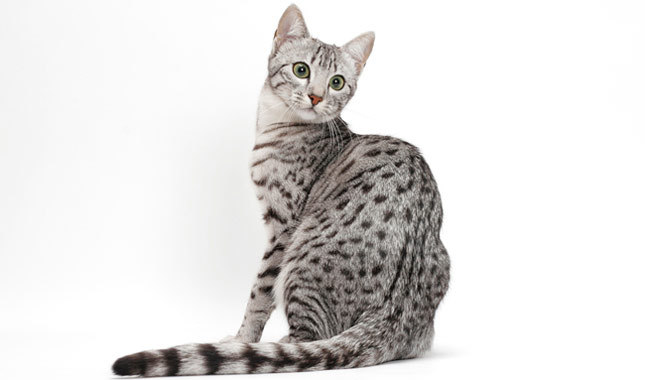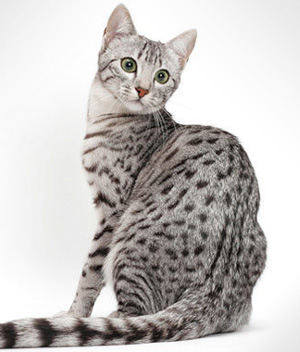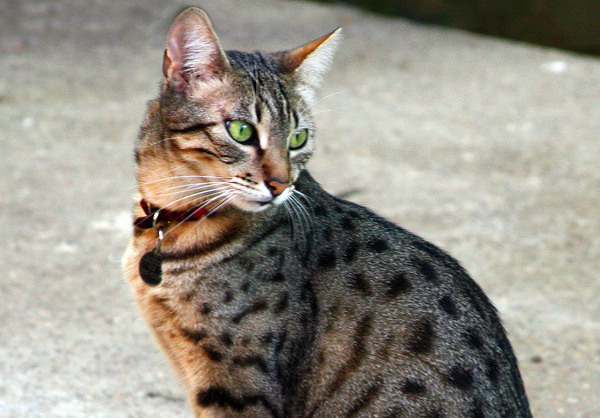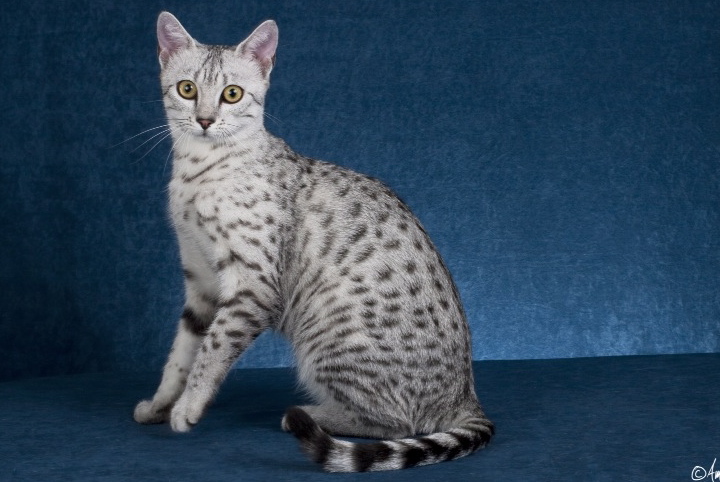
The Breed History
Mau is an Egyptian word for cat-perhaps originally this word was
an approximation of the meow sound. This is the only naturally
spotted domestic cat breed. The first scribed records of the Mau cat
go back to 1400 BC which makes it one of the very oldest known
breeds; they were represented in artwork dating much further
back-about 3000 BC.
It is thought that they were domesticated from spotted African
Wild Cats, Felis libyca subsp. ocreata. Egyptians used to hold cats in
special regard, and frequently mummified them. At one cemetery
site, 300,000 cat mummies were interred. Bastet, daughter of
Ra was the Egyptian goddess of fertility and in statuary, was
represented with a cat head.
Egyptian Mau spotted cats came from Cairo to America in 1956
via Italy. The breed was accepted by CFF in 1968 and accorded
championship status by CFA in 1977. The FIFР№ approved them in
1992. In the UK, Shorthair Oriental Spotted Tabbies were called
"Maus" for a while and this has caused some confusion regarding
the two breeds. No outcrossing is currently allowed. The progenitor
female for the North American lines was a silver cat named Baba.
Physical Characteristics
Weight: 5-12 lb (2-5.5 kg), males larger than females
Coat: The original coat was the spotted pattern in bronze (dark
brown-black spots on bronze agouti), but now silver (charcoal spots
on silver agouti) or smoke (black spots over silver-charcoal body
hairs and white undercoat) are also accepted. Black and blue kittens
occur and can be registered but are pet quality. Agouti hairs have at
least two bands of color striping. Hair is short-medium in length.
Good sharp contrast between spots and background is highly
valued. Spots of the silver and bronze coats can be any size or
shape but should not form any tabby pattern. Bronze cats may
have a pattern limited to the topline though. Some tabby markings
are seen in the Smokes. Forehead pattern is in an M-shape, which
had significance in ancient times, as it reminded the Egyptians of
their sacred scarab. Dark lines extend between the ears back to the
neck. These lines are termed frown marks. Mascara marking lines
the eyes. A dorsal stripe goes down the topline extending to the tail
base. Other specific coat markings such as tail and limb banding
are noted in the breed standards. Hair texture varies between coat
colors but is silky and lustrous in general.
Eyes: Eyes are always a shade of light green (called gooseberry) in
mature cats. Kittens may have amber overtones up to 18 months of
age only. Almond shaped eyes are large.
Points of Conformation: Medium sized cats, they are well muscled,
with rounded-wedge shaped head and medium length muzzle.
There is no break, and ears are large, moderately pointed and
positioned to continue the lines of the face, preferably tufted. Paws
are small and round-oval in shape. Tail is medium-long, tapering
from a thick base, and overall the cat is quite fine in appearance.
They possess a loose skin flap, running from flank to stifle area.
Grooming: The Mau has low grooming needs; a periodic light brush
or hand/chamois will suffice. Towel rather than blow dry if a bath is
needed.
Recognized Behavior Issues and Traits
Reported breed characteristics include: Variable personalities are
present in the breed, from those demanding attention to aloof
cats but overall, are considered well balanced. They are vigorously
playful, and are lively and friendly with family in general. They
chortle and talk softly. Tend to bond closely with one family
member and be fiercely loyal. Can be taught tricks and many will
leash train. Like to jump and sit in high places, so a perch or cat
tree should be provided. Need time to explore new environments, so
it is best to gradually introduce new people and places.
Normal Breed Variations
Are the fastest domestic cat runners checked so far-clocked at 30
mph (48 km/hr).
Deciduous teeth can be delayed in shedding.
May shake their tail when happy; appears as if spraying but no
urine produced.
Slightly longer average gestation period-queens often go up to 70
days.
Best to limit feeding.
Some cats like water, but this does not necessarily translate into
enjoying baths.
Kitten Internet Information Project:
52 litters
192 kittens
3.7 kittens/litter
6% stillbirths
10% C-sections
Female average birth weight: 101 g, male 107 g
Drug Sensitivities
None reported in literature
Inherited Diseases
None reported in the literature
Disease Predispositions
Feline leukemia Virus: Endogenous feline leukemia (enFeLVs) were
studied in a single specimen of Burmese, Egyptian Mau and Persian
breed cats to determine how many loci and where proviruses were
typically inserted. This may indicate genetic propensity for leukemia
genesis in these cats when exposed to the exogenous feline
leukemia virus. They found provirus on 12/18 autosomes, with an
average 19 autosomal copies per cat. One specific locus contained
both homologues in all 3 cats. They were also found on both X and
Y chromosomes.
Back in the time of early breed development, temperament
problems, asthma and cardiomyopathy were mentioned in a fancy
article as predispositions, but careful outcrossing and selective
breeding has helped to control these traits in the breeding pool.
Anecdotal reports of food sensitivity in some lines.
Rare and Isolated Reports
Hypomyelination/Dysmyelination: Case report described
two inbred littermates at 7 weeks of age with clinical signs of
progressive hypermetria/ataxia and bouts of reduced activity and
periodic seizures. Brain and spinal cord had extensive vacuolation or
spongy degeneration of grey and white matter. By 4 months of age,
their overall status was poor, with some dsyphagia. One kitten was
euthanized at 4 months of age, the other kitten gradually improved.
In the litter, one other kitten was stillborn, another died very young,
and yet another developed mild hind limb ataxia at 10 months of
age. The parents had a common sire on both sides. The spongy
degeneration was postulated to result from lowered ATPase activity
in astrocyte mitochondria. A genetic basis was suspected.
Genetic Tests
No commercially available tests
Miscellaneous
- Breed name synonyms: Mau, Egyptian Cat, Spotted Cat
- Registries: FIFe, TICA, CFA, ACFA, NZCF, CCA, WCF, GCCF
- Breed resources: Egyptian Mau Breeders and Fanciers Club
(CFA): http://www.geocities.com/Petsburgh/2369/
Global Egyptian Mau Society: http://www.egyptianmau.org/
The Egyptian Mau Club (UK):
http://www.egyptianmaus.co.uk/
National Egyptian Mau Council (CFA):
http://www.egyptianmaubc.org/records.html
Photo Gallery of Breed - Egyptian Mau - Cat Breed








 Animalia Life
Animalia Life